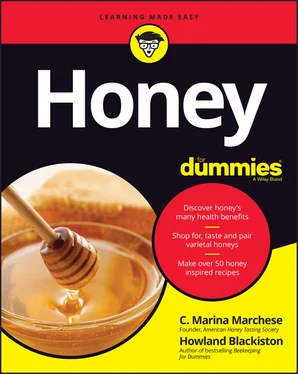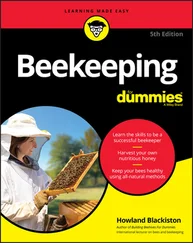Bee pollen is said to be nature’s most complete food, containing every nutrient needed to sustain human life. It is a complete source of protein that contains all the basic elements in the human body, including 22 amino acids, 18 vitamins, 25 minerals, 59 trace elements, 11 enzymes or co-enzymes, fatty acids, and carbohydrates. Chock-full of B-complex vitamins and C, D and E, many people consume bee pollen orally for nutrition value similar to a daily vitamin.
Athletes swear that bee pollen increases energy and endurance during competitions. However, the most common reason people consume bee pollen is to build up a natural immunity, especially to seasonal pollen allergies. After all, allergy shots are injections of pollen and other allergens to build your body’s own natural immunity to what you are allergic to, so why not eat your medicine? Sprinkle some bee pollen on salads, or mix it into power smoothies, yogurt, or oatmeal. Since bee pollen is considered a raw superfood, it should be kept refrigerated and consumed within a few months of harvest.
Probably the most mysterious substance produced by honey bees is a milky white liquid called royal jelly. You may have seen royal jelly as an ingredient in power drinks, facial creams, or even supplements at your natural food shop and had no idea what it was. Secreted by the hypopharynx glands of young nurse bees to feed young growing larvae inside their cells, royal jelly is best known as the magical food of the queen. It is what gives her fertility and the supernatural ability to lay up to 2,000 eggs a day. It is also why she lives three to five years longer than any other bees, essentially increasing her longevity.
To gather one ounce of royal jelly, you would have to visit 120 queen cells, and in fact it is not always present in every hive unless the colony is actively rearing a new queen. For this reason royal jelly is extremely rare, labor intensive to harvest, and costly.
Royal jelly is another superfood chock-full of amino acids; vitamins A, C, D, E, and B-complex; and trace minerals, as well as calcium, copper, iron, potassium, phosphorus, silicon, and sulfur, essential fatty acids, sugars, sterols, and acetylcholine, a neuronal transmitter. These elements are necessary for human survival and maintaining a healthy the immune system.
Royal jelly also contains collagen that benefits the skin, hair, and nails, making it a popular ingredient in personal care products. A potent antimicrobial protein called royalisin has also been found in royal jelly. In addition, royal jelly has been touted to aid in mood disorders and insomnia, repair nerve cells, strengthen liver function, and aid in digestive disorders. Considering all the benefits that royal jelly offers, I can tell you from experience that royal jelly is extremely sour and tastes like a seriously stinky cheese, but many things that are good for you do not always taste good.
Beekeepers curse propolis because it sticks to their hands, hive tools, and the frames inside the hive while they are inspecting their colonies. For this reason, it is often called “bee glue,” and it leaves a permanent stain on everything it comes into contact with. A type of tree resin similar to myrrh and frankincense, propolis is produced when honey bees gather the sticky sap from conifer trees like spruce, pine, or fir. They mix the sap with their own enzymes and beeswax to produce one of the most powerful antibacterial, antifungal and antiviral substances in the natural world.
Propolis resembles sticky taffy when it’s warm, and it shatters like glass when it’s cold. Beekeepers scrape chunks of propolis from the woodenware inside their hives and save it to make tinctures, dissolving it with grain alcohol. Personal care items like topical salves, throat sprays, lozenges, and toothpaste found in most health-food stores tout the benefits of propolis. If you have infected gums, a toothache, or a sore throat, try sucking on a small piece of propolis; it will relieve pain pretty quickly by numbing the area. Because propolis contains essential minerals, iron, calcium, aluminum, manganese, and all the vitamins known to man except vitamin K, it is known to stimulate the body’s own immune system.
The name propolis was dubbed by Aristotle when the ancient Greeks observed bees calking the crevasses in their hives to fortify against bacteria in preparation for the oncoming winter. Propolis translates to pro (before) and polis (city) referring to a bee colony’s ability to defend its own city. It is a well-known fact that the ancient Egyptians used propolis and honey to embalm the mummies, and for this reason they have survived for thousands of years. Stradivarius polished his violins with beeswax and propolis, which acted as a preservative for the wood. Today, beekeepers often mix tinctures of propolis with paint to preserve the woodenware of their beehives.
After honey, beeswax is the most commercially valuable and labor-intensive product made by honey bees. Beeswax is secreted by glands on the bottom of the female workers’ abdomens as tiny white flakes. Then they form it into hexagonal cells, creating a repeating pattern that becomes honeycomb. These beeswax cells are where the bees store their honey, pollen, propolis, and beebread. The beeswax cells also serve as the nest where the bees live and the queen will lay her eggs. An interesting fact is that while bees are constructing their honeycomb with beeswax, they can be seen linking themselves together by their feet, creating a single chain. There does not seem to be any explanation for this behavior. Some say they are re-creating scaffolding or they are simply using their own bodies to measure the size of each hexagon they build. Either way, we can all agree that honey bees are master builders and mathematicians.
Producing beeswax and building honeycomb are not only labor intensive for bees, but harvesting beeswax and honeycomb is also labor intensive for the beekeeper. Over time beeswax becomes visibly old, turning black and stinky from overuse by the bees. Beekeepers know it is time to swap it out and replace it with new frames of beeswax foundation for the bees to build new honeycomb.
Thrifty beekeepers harvest their beeswax and clean it by boiling it in water then straining out the excess honey and any residual particles a few times until the beeswax is clean and bright yellow again. This can take hours, mostly because of the time needed to boil and cool down the beeswax in between straining.
Beeswax can be used to make candles and mixed with oils, butters, and scents to make personal care products or even wood polish. Beeswax candles are highly desirable because they burn two to three times longer and cleaner than paraffin wax. Beeswax candles are also an ecologically safe choice for the environment because they do not emit toxic smoke or messy drips. It is said that the light from a burning beeswax candle is identical to sunlight.
When used as an ingredient in skin care or hair products, beeswax has a warm, nostalgic, honey scent. It is emollient, allowing oils and butters to absorb completely into the skin to moisturize, while offering antibacterial properties and a certain amount of protection from the sun.
Enjoying the Many Benefits of Honey
And now to the star of this little book: honey. It’s a truly magical substance that cannot be replicated by humans. Although some have successfully made a sweet, syrupy substance that tastes very similar, it is impossible to mimic honey’s chemical composition or its unparalleled health benefits. Beginning with its low pH, honey is an acidic environment, inhibiting the growth of most bacteria, fungi, and viruses, which prefer to thrive in a more alkaline state. Honey registers at 3.2–4.5 on the pH scale, much lower than most pathogens can survive.
Читать дальше












